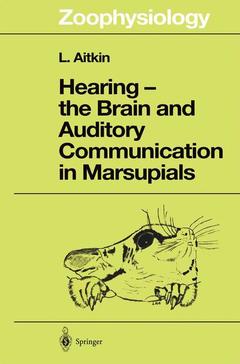Hearing — the Brain and Auditory Communication in Marsupials, Softcover reprint of the original 1st ed. 1998 Zoophysiology Series, Vol. 36
Langue : Anglais
Auteur : Aitkin Lindsay

This monograph evolved from years of research into the auditory pathway and hearing of many species of marsupials. Its function is to give biologists, in par ticular neurobiologists, a broad description and review of what is known of the auditory sensory capacities and processing mechanisms in this large order of mammals. My initial interest in marsupials developed from collaborative work with Dr. Richard Gates at Monash and Melbourne Universities in the 1970s and by curiosity as to whether concepts about the auditory system was stimulated stemming from experiments mainly on domestic cats could be extended to mam mals of other orders. My subsequent interest in Australian marsupials, aroused by collaboration with Dr. John Nelson at Monash University in the 1980s and 1990s, concerned their auditory systems and behavior per se and not as primitive cousins of eutherians. More recently, I have collaborated with Dr. Bruce Masterton at Florida State University in studies of New World marsupials. His sad death in 1996 has robbed neurobiologists of one of our most provocative thinkers and hypothesis testers. I would like to thank the Department of Physiology at Monash University for making many facilities available to me, the National Health and Medical Research of Australia and the Australian Research Council for providing funds for Council research, and Jill Poynton and Michelle Mulholland, who illustrated this volume.
1 Introduction.- 1.1 Why Study Marsupials?.- 1.2 Evolutionary Considerations.- 1.3 Taxonomic Considerations.- 1.4 Ecological Considerations.- 1.5 The Approach of this Volume.- 2 The Design of the Mammalian Auditory System: A Brief Overview.- 2.1 Structure and Function of the Organ of Corti.- 2.2 Cochlear Potentials.- 2.3 Anatomy of Auditory Nerve and Brainstem.- 2.4 Anatomy of Thalamocortical Auditory System.- 2.4.1 Auditory Cortical Fields.- 2.4.2 Connections of Cortical Fields.- 3 Hearing of Marsupials.- 3.1 Behavioral Measurements.- 3.2 Electrophysiological Measures.- 3.2.1 Cochlear Potential Thresholds.- 3.2.2 Single-Unit Thresholds.- 3.2.3 Auditory Brain Stem Response (ABR).- 3.3 Future Research Directions.- 4 What Do Marsupials Listen To?.- 4.1 Vocalizations and Speech.- 4.2 Vocal Behavior of Adult Marsupials.- 4.3 Hearing Sensitivity and Vocal Spectra of Adults.- 4.4 Adult and Neonatal Hearing and Vocal Relationships.- 4.5 Hearing Sensitivity and the Sounds of Prey and Predators.- 4.6 Future Research Directions.- 5 Auditory Periphery of Marsupials.- 5.1 The Outer Ear.- 5.2 Middle Ear Structures.- 5.2.1 Evolution of Middle Ear Bones.- 5.2.2 Middle Ear of Marsupials.- 5.3 Cochlea.- 5.3.1 Evolution of Sound Reception.- 5.3.2 The Cochlea of Marsupials.- 5.3.3 Cochlear Potentials in Marsupials.- 5.4 Future Research Directions.- 6 Auditory Structures of the Brainstem.- 6.1The Marsupial Brain.- 6.2 Auditory Nuclei of the Medulla.- 6.2.1 Cochlear Nuclear Complex.- 6.2.2 Superior Olivary Complex.- 6.3 The Auditory Midbrain.- 6.3.1 Cytoarchitecture of the Inferior Colliculus.- 6.3.2 Afferent Connections of the Inferior Colliculus.- 6.3.3 Efferents from the Inferior Colliculus.- 6.4 Physiological Studies of the Auditory Midbrain.- 6.4.1 Tonotopic Organization of the Central Nucleus of the Inferior Colliculus and Frequency Selectivity of Single Units.- 6.4.2 Auditory Midbrain and Sound Localization.- 6.4.3 Auditory Midbrain and Acoustic Reflexes.- 6.5 Future Research Directions.- 7 Thalamocortical Auditory System.- 7.1 Medial Geniculate Body.- 7.1.1 Structure.- 7.1.2 Afferent Co0nnections.- 7.1.3 Comparisons with Lateral Geniculate Nucleus (LG) of Marsupials.- 7.2 Evolution of the Neocortex.- 7.3 Auditory Cortical Fields in Marsupials.- 7.4 Auditory 0Cortical Connections of Marsupials.- 7.5 Effects of Lesions of Cortical Areas on Behavior.- 7.6 Future Research Directions.- 8 Development of the Auditory System.- 8.1 Why Marsupials Are Important to the Developmental Biologist.- 8.2 Embryogenesis of the Auditory System and Growth of Young Marsupials.- 8.3 Physiological Measures of the Onset of Hearing in Marsupials.- 8.4 Development of the Auditory Periphery.- 8.4.1 Mechanical Structures.- 8.4.2 Ultrastructural Development of the Cochlea in Eutherians.- 8.4.3 Ultrastructural Development of the Cochlea in Monodelphis.- 8.5 Anatomical Changes in the Brain.- 8.5.1 Cytogenesis, Migration and Formation of Nuclei.- 8.5.2 Development of Dendrites in the Inferior Colliculus.- 8.5.3 Development of Connections and Synapses in the Inferior Colliculus.- 8.5.4 Concerning the Determinants of Synaptogenesis.- 8.6 Future Research Directions.- 9 Conclusions.- 9.1 Hearing Sensitivity.- 9.2 Relationship Between Hearing Range and Vocal Behavior.- 9.3 The Marsupial Auditory Pathway.- References.
Information on marsupials provides vital insight into the development of all mammals
This book brings together what is known about one very important sense for survival sense: hearing
Date de parution : 10-2012
Ouvrage de 119 p.
15.5x23.5 cm
Thèmes de Hearing — the Brain and Auditory Communication in... :
© 2024 LAVOISIER S.A.S.



